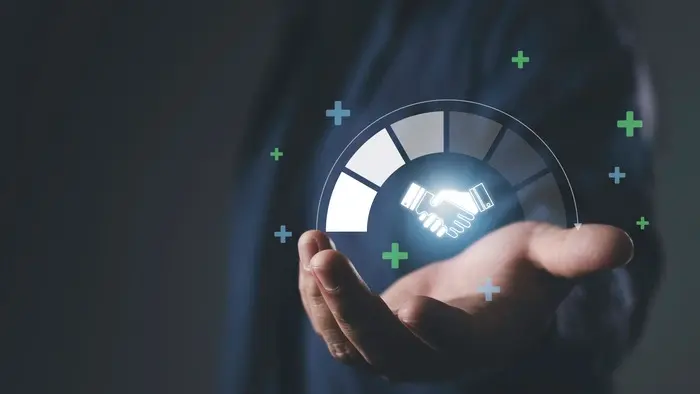Why Authenticity and Transparency are Critical for Video Production in 2025
With so much content available online, audiences are sharper than ever at detecting what feels genuine—and what doesn’t. Overly produced videos with...
Artificial Intelligence is virtually everywhere. In fact, it’s all that today’s marketers are talking about. In the birth of this new technological tool, many people are asking themselves: Is AI helping or hurting businesses?
My answer? It’s both.
AI-generated video can be a game-changer when used strategically. It can even cut production time down by up to 80%. This is especially useful when sharing a high-level message or internal announcement quickly, turning around a full video in hours rather than days. The same is true for online advertising, where you might want short, more attention-grabbing videos. AI allows these ads to be produced faster and more cost-effectively, freeing up marketing teams to focus on strategy rather than production logistics.
It also shines when a lot of content needs to be produced. If you need dozens of variations of the same video, that might be used in multiple languages or markets, you can rely on AI to keep messaging consistent and timelines manageable. AI can also help with generating unique ideas for each of those audiences. In these situations, AI helps teams move quickly and deliver content without waiting for cameras, crews, and lengthy post-production schedules.
Here’s the thing: AI-generated video has a time and a place. If every piece of content feels templated or overly polished, you risk losing the very thing that makes video so powerful — the human connection. In fact, research shows that, in a sample of 1,000 individuals, 87% prefer real humans in video over an AI-generated avatar. Emotionally driven topics like your brand story, your company culture, and your founder’s vision will resonate differently when they’re delivered by real people.
In fact, research shows that 98% of consumers agree that “authentic” images and videos are pivotal in establishing trust. That means businesses can’t afford to rely solely on automated, polished content, especially when the goal is to build credibility.
The same is true for testimonials. Customers want to see and hear other humans sharing their experiences, not an avatar reciting scripted lines. Credibility is built through authenticity, and while AI can mimic a lot, it can’t replicate the trust that comes from watching a real person speak about their journey.
And then there are other moments, like recruiting videos, day-in-the-life clips, behind-the-scenes peeks, that thrive on spontaneity and human warmth. These moments are what make a brand feel approachable and relatable. AI, at least for now, can’t be relied on to capture the subtle facial expressions, natural body language, or unscripted interactions that bring those moments to life.
So how do you know when to use AI versus professional production? Here's a straightforward way to think about it.
Your timeline is 48 hours or less
The content will be updated frequently
You need personalization at scale across different audiences
The message is straightforward and informational
Budget constraints are significant
Building trust is the primary goal
The content represents your brand for the long term
Emotional connection matters to your message
The subject is complex or sensitive
Authenticity is non-negotiable
Think of it this way: if the video is customer-facing and meant to build trust, represent your values, or handle something delicate, that's when you need real people and professional production. If you're communicating internally, testing concepts, or need quick turnaround on tactical content, AI can get the job done.
Understanding the financial side helps clarify when each approach makes sense.
AI video platforms typically run $20-200 per month for subscriptions, with some charging per video. That seems affordable until you factor in the learning curve, revision limitations, and the time spent getting results that actually work. For straightforward content at high volume, the math works out. For anything requiring multiple revisions or nuanced messaging, costs add up quickly.
Professional production varies widely based on complexity, but expect $5,000 - $10,000 for a solid brand video and $1,000-3,000 per video for simpler projects like employee spotlights. The upfront cost is higher, but you're getting content that lasts, builds trust, and often performs better in the metrics that matter—engagement, conversions, and brand perception.
The real question isn't just "what does this cost?" It's "what's the cost of getting this wrong?" A poorly executed AI video on your homepage can hurt your credibility. A generic internal update probably won't.
As businesses experiment with AI video, we're seeing patterns in what doesn't work.
Don't use AI for high-stakes content without human review. Even if you're on a tight timeline, have someone watch the final product with fresh eyes before it goes out. AI can miss context, tone, or cultural nuances that hurt rather than help your message.
Don't let AI determine your entire content strategy. It's a tool, not a replacement for strategic thinking about what stories matter most to your audience.
Don't ignore audience feedback about AI content. If engagement drops or comments suggest people find it impersonal, that's data worth paying attention to.
Don't assume "good enough" AI video won't affect your brand. Every piece of content shapes how people see you. Mediocre content, repeated over time, becomes your reputation.
People often talk about AI-generated video like it’s a black-and-white choice — you’re either all in or completely against it. But it’s not that simple. AI video absolutely has a place in today’s marketing world, especially when you need something fast and scalable. It’s great for high-level announcements, quick updates, or targeted ads that don’t need weeks of planning and production. The real trick is knowing when to use it.
In fact, some of the smartest approaches we're seeing combine both. Companies are using AI to create first drafts or test concepts, then bringing in professionals to refine the final product. Others shoot core content professionally, then use AI to create variations for different markets or platforms. Or they'll handle the professional shoot and use AI-assisted tools in post-production for faster turnaround on edits and adaptations.
The hybrid approach gives you speed and flexibility without sacrificing the human touch where it matters most. To get the most out of AI video, you have to be thoughtful about where it fits and when it's worth investing in something more human and hands-on.

With so much content available online, audiences are sharper than ever at detecting what feels genuine—and what doesn’t. Overly produced videos with...

One of the most common questions we hear from clients, who are first-time video producers, is: "Do I need a script?" The answer is… maybe. It isn't a...

Visual content continues to dominate the digital world’s center stage. That’s why leveraging video’s capacity to tell stories, engage with your...